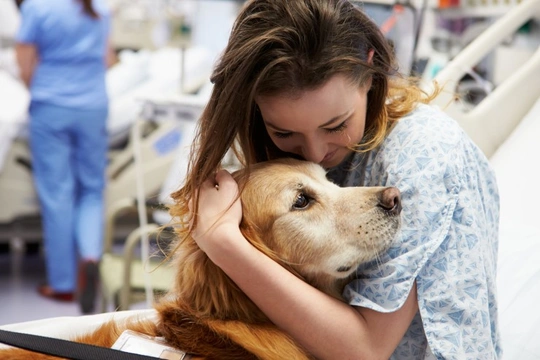
What does it take to turn your dog into a therapy dog?
A therapy dog is a dog that can be taken to venues such as hospitals, hospices, private homes and other places, to allow people who may benefit from it to meet and spend some time with a dog.
This is understandably rather different than being a service dog, which requires years of training and management and a lot of money-and many therapy dogs are privately owned by people who are prepared to put in some time and effort to teach your dog the essential skills that they will need.
If you are wondering what it takes to turn an everyday pet dog into a therapy dog, or are wondering if your own dog has what it takes, read on to find out more about the core traits all good therapy dogs possess, and how to assess your own dog.
Why are therapy dogs useful?
Many people love dogs, and as any dog owner will tell you, simply spending time with your dog or being greeted by them after a hard day at work can really lift your mood. Many people think of their dogs as their best friends and a vital part of their life-and many people who do not own a dog or for whatever reason cannot be with their dogs feel the same way.
This may include people who are in hospital, long-term hospice care or who have psychiatric issues, as well as people of all ages with conditions such as autism, who often find communicating with a dog much easier than communicating with other people.
Therapy dogs can be taken into such environments where regular dogs are not allowed to go, and let people meet, pet and spend time with them, providing a much-needed mental lift and spreading a lot of happiness as they go! This can make hospitalisation or medical treatment much more bearable for many, and give them something to look forwards too.
Are therapy dogs and assistance dogs the same thing?
Many people think that therapy dogs and assistance dogs are essentially the same thing, but this is not true. Therapy dogs are essentially simply very good, very kind and loving dogs, while assistance dogs are trained to help to protect people’s independence and keep them safe, which requires a huge range of skills and lots of training.
Also, while therapy dogs are permitted into some places that are usually off limits to dogs at certain times and in certain settings, the rest of the time, a therapy dog is simply a pet, and they cannot accompany you to places where genuine assistance dogs are permitted to go.
What are the core traits of a good therapy dog?
There are a huge range of different traits that a good therapy dog possesses, and any breed of dog may potentially have what it takes-there are no restrictions on things like age and size, assuming that the dog is adult, fit and suited for the role.
The first and most important element of a good therapy dog is safety and temperament-therapy dogs must be completely safe around people from all walks of life and of all ages, in all sorts of different situations.
This means that a dog that is great with adults but not kids will not be a good fit, and a dog that has shown any form of aggression even under provocation, including defensive aggression, will not be able to continue.
Therapy dogs must be highly social with both people and other dogs, and should also be generally calm, open and not phased by new situations.
They should also be enthusiastic about meeting new people, kind, loving and friendly, while also able to moderate their behaviour instinctively to avoid inadvertently hurting someone who may be ill or not fully mobile.
They must also be well trained, highly obedient and able to keep their heads and respond to commands when a lot of stimulus is competing for their attention!
How to get started
The foundations of a good therapy dog are good training in the basics, a high level of obedience, excellent social skills, an outgoing and friendly nature, and absolutely zero signs of aggression.
To begin with, ensuring that your dog ticks all of these boxes is a good start, and continually introducing your dog to new people and new stimulus will all help.
Ensure that your dog follows their commands and can sit, stay, walk nicely on the lead and come when called, and monitor them carefully for potential problems.
From this point, you might want to contact an organisation (there are several across the UK) that hold training courses and certifications for assistance dogs, and that may be able to put you in touch with people or organisations that would love a visit from your dog!
Before you do actually go out on a visit, you must also ensure that your dog is covered by the appropriate insurance policy-this may be provided by the organisation, or you may have to attain it privately.
If your dog is already insured, you may need to let your insurer know if you intend to use them as a therapy dog too, as this may change your policy.



